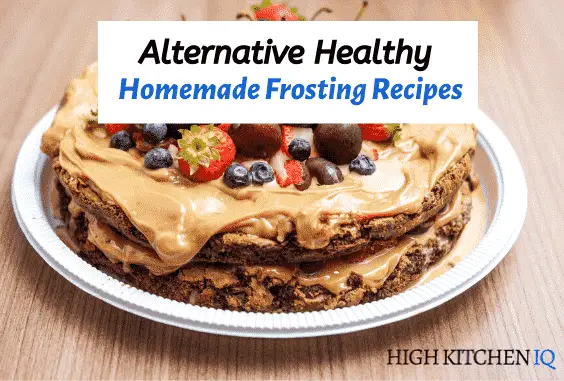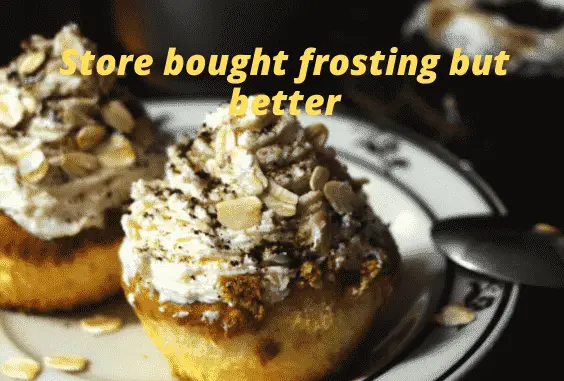6 Tips to Make Any Frosting Healthy & 5 Alternative Recipes

Everyone loves frosting on top of their desserts, however, we tend to deprive ourselves of it because of regular frosting tends to be very unhealthy.
Did you know that traditional frostings on average may contain 350-400 calories in just two tablespoons?.
Now you can cut into the calories of frostings by tweaking a few ingredients and replacing them with healthier options.
So in this article, I hope to change that & help you to make and enjoy amazingly tasty yet healthy frosting.
How to make Homemade Frosting Healthier
You can make homemade frosting healthier by using:
- Healthier Sweeteners in your Frosting
- Alternatives to Butter
- Natural Food Coloring
- Dairy-Free Milk
- Egg Replacements
- Better Alternatives to Cream Cheese
1. Use Healthier Sweeteners
Sugar, when used in moderation, is not generally unhealthy but most frosting recipes require large quantities of sugar, especially powdered sugar.
If you are still keen on using sugar in your frosting, I would recommend that you make your own powdered sugar at home. This will eliminate the use of preservatives.
It is so easy to make your own powdered sugar at home. Store-bought powdered sugar is usually made out of super refined sugar and mixed with corn starch to prevent caking.
You can leave the cornstarch out of your recipe and use powdered sugar that is less processed.
Below is a recipe for making powdered sugar free of cornstarch
Homemade Powdered Sugar Recipe
Ingredients:
- 1 cup of Organic Brown Sugar (this will make twice the amount of powdered sugar)
Method:
- Place the granulated sugar into a food processor or blender.
- And then pulse until its in a powdered form.
- Now you can use it as required in the recipe.
Five Sugar Substitutes for Frostings
Using healthier sweeteners can eliminate the sugar required or reduce the quantity needed.
You can essentially make the frosting healthier and lower in calorie, allowing you to eat your dessert guilt-free.
Some sugar substitutes you can use in frostings are:
1- Fruits add a level of sweetness and a degree of texture as well as vitamins and minerals to frosting.
Fruits such as pitted Medjool dates are sweet with a sturdy texture and add a beautiful caramel color to frosting. Fruit jams such as raspberry and strawberry can also add natural sweetness as well as great flavor.
2- Erythritol is a type of a sugar alcohol, used as a food additive and sugar substitute.
Erythritol occurs naturally in some fruits and fermented foods Manufacturers add an industrially fermented version to low sugar and sugar-free food and drink options. Popular brands include Swerve and Truvia.
3- Honey cannot be used alone as a sugar substitute because of the liquid consistency but it can reduce the amount of sugar needed.
4- Stevia rebaudiana (Bertoni) is a South American plant native to Paraguay that has been used to sweeten beverages and make tea.
With so many debates on the use of artificial sweeteners, I found in my research that Stevia has no effect on either blood pressure or blood glucose response making Stevia safe to use by diabetics.
5- Sucralose also known as Splenda, heats well, and it has no bitter aftertaste at all.
It is approved by the FDA and is extremely potent. It is 600 times sweeter than regular table sugar.
2. Use an Alternative to Butter
Traditional butter is a product of the animal agriculture industry. It is made by churning fresh cream or milk usually from a cow to separate the butterfat from the buttermilk. Butter usually consists of 80 percent fat, 15 percent water, and 5 percent protein.
Healthy Butter Substitutes For Frosting
To solve this problem I have found some healthy alternatives to replace butter in your frosting. There are:
- Using fruits and vegetables that have a creamy consistency e.g Avocado, Pumpkin, chickpeas, banana, etc.
- Whipping cream creates a fluffy, lighter frosting that can replace butter. For every 1 cup of butter use 3 cups of heavy whipping cream.
- Using vegan butter- this is free of animal products. The ingredients found in vegan butter may differ from brand to brand but it is usually made from some type of oil e.g olive oil, coconut oil
Side Effects of Using too Much Butter
In most Frostings the use of butter in large amounts is traditional and I agree, butter is delicious but it has a high fat content as well as a high calorie count. Butter is also shown to increase LSD cholesterol.
The American Heart Association is recommending that anyone who wants to lower their LDL cholesterol should not consume more than 5–6 percent of their total calorie intake from saturated fat.
3. Use Natural Food Coloring
It is important for food to look just as good as it tastes, however, artificial food coloring contains so many chemicals.
Artificial food coloring was originally manufactured from coal tar, which comes from coal. Today, most artificial food dyes are derived from petroleum, or crude oil. Since they are inexpensive and stable under heat and light conditions, artificial colors have become increasingly popular in the food industry.
Side Effects of using Artificial Food Coloring
Studies suggest there is a small but significant association between artificial food dyes and hyperactivity in children. Some children seem to be more sensitive to dyes than others.
Some artificial food dyes may cause allergic reactions in sensitive individuals.
Food dyes are likely not dangerous for most people, but avoiding processed foods that contain dyes can be beneficial to your health.
Natural Substitutes You Can Use As Food Coloring
These natural food coloring will brighten your frosting without adding any chemicals. You won’t taste the fruits or vegetables flavor in the frosting because you are using such small amounts e.g
- Orange: carrots, paprika.
- Red: beets, tomato, raspberries, pure pomegranate juice
- Yellow: saffron, turmeric, mango.
- Pink: strawberries, raspberries.
- Green: spinach.
- Purple: blueberries, purple sweet potato.
- Brown: coffee, cocoa.
- Blue: red cabbage + baking soda, radicchio
You can also make the primary colors and mix two colors together to get other colors.
How to Make Red Natural Food Coloring
Ingredients
- 1/4 cup canned beets drained
- 1 teaspoon of beet juice (From a can)
Method
- In a blender or food processor, blend the beets and juice together until smooth.
- Next, pass the blended liquid through a sieve to remove the beets and save the beet liquid which is your food coloring.
- Add 1 teaspoon at a time until you get your desired color
- Refrigerate the remainder in an airtight container for 2 weeks
How to Make Yellow Natural Food Coloring
Ingredients
- 1/4 cup water
- 1 teaspoon Tumeric
Method
- Put in your ingredients in a saucepan and bring to a boil for 2-3 minutes.
- Let it cool completely.
- Finally, add to the frosting one teaspoon at a time until you get desired color
- Refrigerate the remainder in an airtight container for 2 weeks
How to Make Green Natural Food Coloring
Ingredients
- 1 cup spinach
- 3 tablespoon water
Method
- If using fresh spinach, in a small saucepan, simmer the spinach and water for 2-3 minutes.
- Don’t cover the spinach as it will dull the green color
- Now if using frozen and thawed spinach skip this step
- In a blender or food processor, blend the spinach and water together until completely smooth.
- Pass through a sieve to remove the leaves
- Add to the frosting one teaspoon at a time until you get the desired color.
- Refrigerate the remainder in an airtight container for 2 weeks
How to Make Blue Natural Food Coloring
Ingredients
- 2 cups shredded red cabbage
- 1 and a 1/2 cups of water
- 1/2 teaspoon baking soda
Method
- Combine 2 cups shredded red cabbage and 1 and 1/2 cups of water in a small pot.
- Bring the mixture to a boil.
- Remove the mixture from the heat and let it steep for 15 minutes.
- Strain, then return the mixture to the pot.
- Reduce to 3 to 4 tablespoons, then stir in a small pinch of baking soda this will turn the color from purple to blue.
- Cool completely.
- Add 1 teaspoon blue color to frosting until you get the desired color.
- Refrigerate any leftovers in an airtight container for 2 weeks
4. Use Dairy Free Milk
Milk adds a level of richness and creaminess in your frosting. It also helps to dissolve the sugar and also giving it a more flexible consistency.
Why You Shouldn’t Use Milk
Milk is not unhealthy, if used in the proportion recommended but there are some people have lactose-intolerant problems.
This means that the lactose in cow’s milk can be difficult for them to digest, resulting in nausea, cramps, gas, bloating, and diarrhea.
A single serving of milk can contain as much as 24 mg of heart-harming cholesterol.
Also, some many people chose not to use animal products such as milk for different reasons such as veganism or religious beliefs
Therefore you can replace regular milk with other milk substitutes in your frosting.
Some dairy free milk options are Almond Milk, Coconut Milk, Cashew Milk etc.
Some other substitutes that can be used instead of milk in frostings are water and orange juice.
5. Use Egg Replacements
Eggs are used in frostings such as Royal Icing. If you don’t like the thought of using raw eggs in your frosting. Here are some options to replace them :
- Creating an egg substitute by dissolving unflavored gelatin in hot water, letting it set.
- Substitute meringue powder or eggs with dried/dehydrated egg whites.
6. Healthy Options to Use Instead of Cream Cheese
Cream Cheese is delicious but if you want to try other options that are lighter than cream cheese try Greek yogurt or whipped cream.
Some Healthy Frosting Recipes
1- Greek Yogurt Frosting Recipe
This Tangy but sweet frosting is perfect to use on carrot cakes.
Ingredients
- 2 cups plain Greek yogurt
- 1 teaspoons pure vanilla extract
- 1 cup powdered sugar
Method
- Place a fine-mesh strainer over a small bowl. Place the yogurt in the strainer.
- Cover the bowl and place in the fridge to drain for at least three hours. If you omit this step the yogurt will be too liquid to make a sturdy frosting.
- Using an electric hand mixer set on medium speed, beat together the strained yogurt, the vanilla, and the powdered sugar.
- Refrigerate until you are ready to use. This adds more structure to the frosting.
2- Chocolate Frosting Recipe (Sugar-Free)
This is a decadent chocolate recipe that uses Medjool dates as a sweetener.
This recipe may not be as fluffy as traditional frosting but it every bit as delicious. 1/2 cup of dates contains around 60 grams of sugar whereas 1/2 cup of sugar is closer to 100 grams.
Additionally, dates contain lots of fiber as well as vitamins and minerals. This recipe is vegan.
Ingredients
- 10 large pitted Medjool dates
- 3/4 cup hot water
- 1/3 cup cocoa powder
- 1 tablespoon almond butter
- 1/4 teaspoon salt
Method
- First, add the pitted Medjool dates into a food processor along with the hot water.
- Then let it soak for 10 minutes
- Next add the cocoa butter, almond butter and salt
- Now if the frosting is too thick you can add one tablespoon of water at a time until you get the consistency you want.
- Finally, pulse until smooth.
3- Vanilla Frosting (made with Swerve)
Ingredients
Swerve has no calories or net carbs and is certified non-GMO and non-glycemic, which means it does not raise your blood sugar and is suitable for diabetics. It is an erythritol sugar substitute and has the consistency of powdered sugar.
Swerve is ideal for cooking as it bakes, tastes and measures cup for cup like regular sugar.
- 3 cups Swerve Use this recipe as you would use powdered sugar.
- 1 cup butter softened to room temperature.
- 1 tablespoon whipping cream (can use up to 2 tablespoons if you want a more liquid frosting).
- 1 vanilla bean scraped
Method
- Add the butter and Swerve to a bowl and mix well with a hand mixer.
- Slowly incorporate the whipping cream and vanilla bean.
- Spread or pipe over your favorite desserts.
4- Raspberry Whipped Cream (sugar-free)
Ingredients
- 1 cup whipped cream
- 1/4 cup raspberry jam seedless
- 1 teaspoon vanilla extract
- Natural food coloring
Method
- Using a hand mixer blend the whipping cream until stiff peaks form
- Slowly using a spatula mix in the raspberry jam, vanilla extract and food coloring
- Mix well
5- Chocolate Avocado Frosting Recipe (no butter)
Ingredients
- 2 large ripe avocados
- 1/2 cup cocoa powder
- 6-8 tbsp honey
- 1/4 tsp pure vanilla extract
- 1 small pinch salt
- 2 tbsp almond milk
Method
- Put all ingredients into a blender/food processor.
- Pulse until smooth.
- You should make this frosting right before you are ready to use it and refrigerate leftovers.



